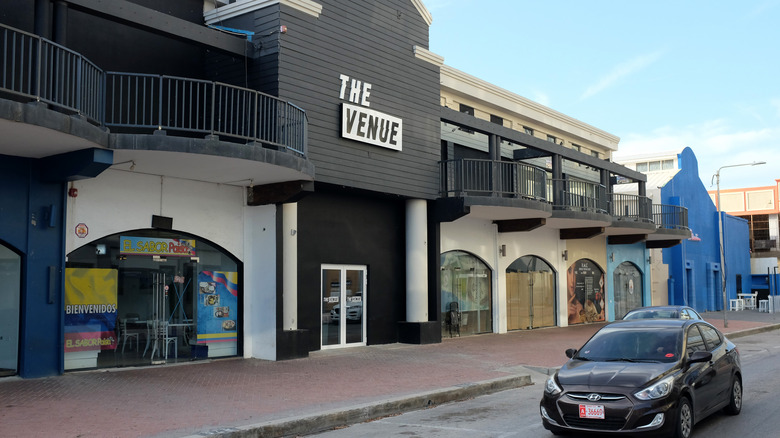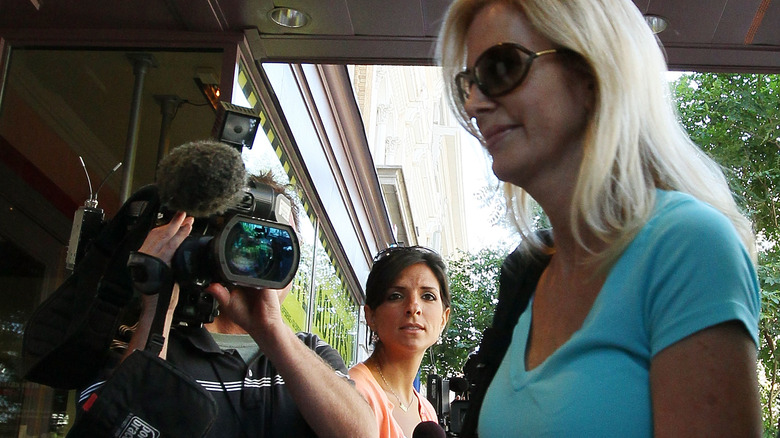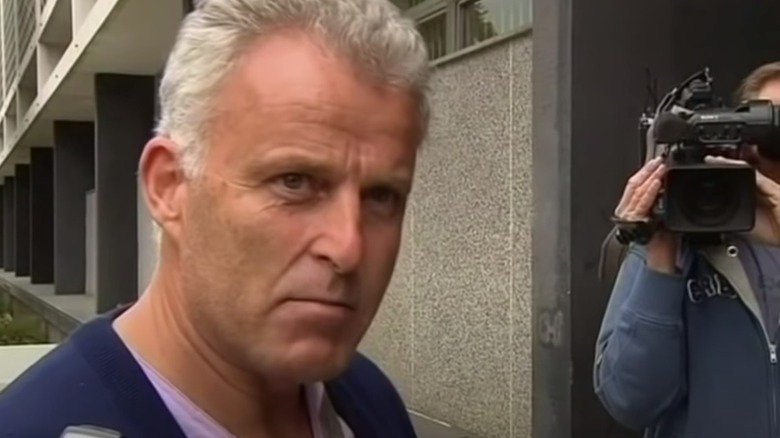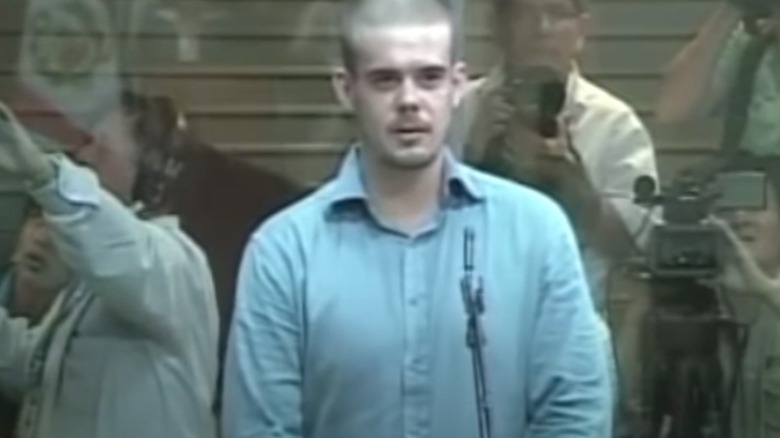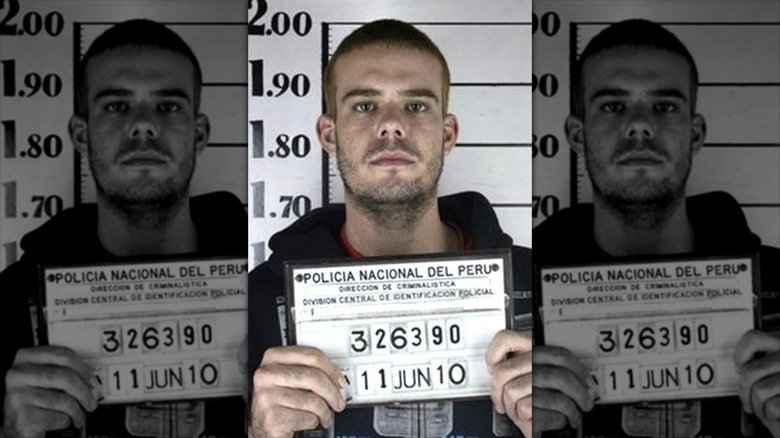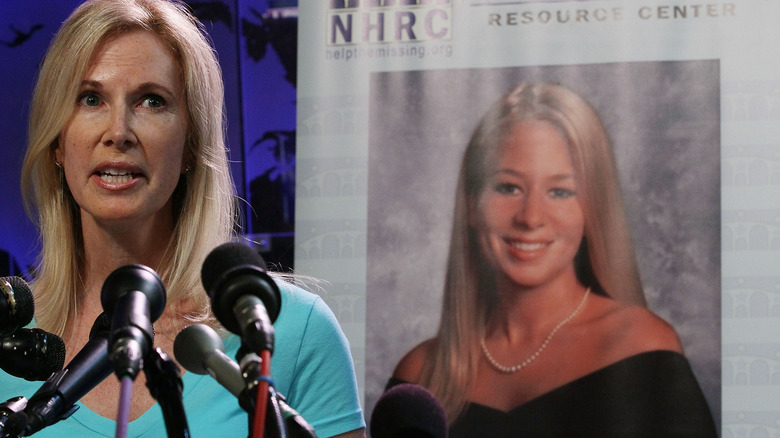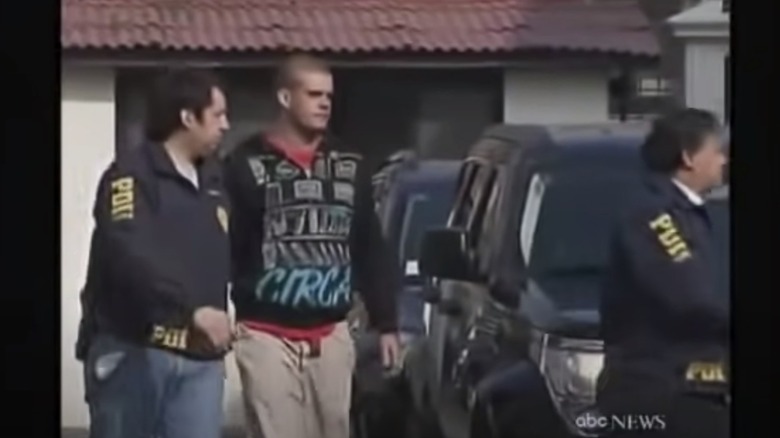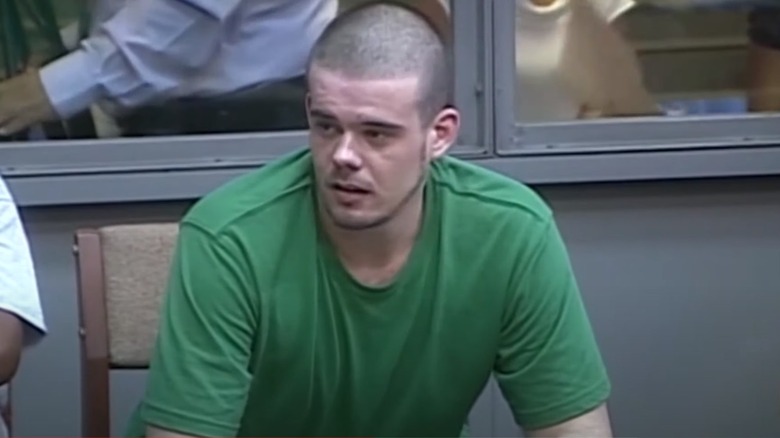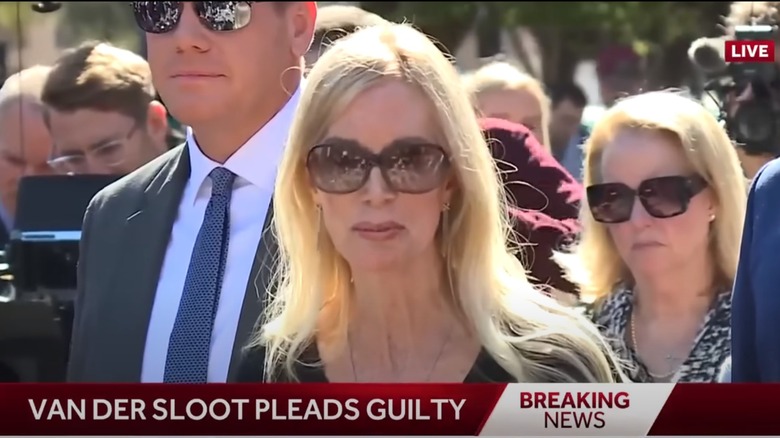Natalee Holloway: The Entire Tragic Timeline Of Her Disappearance Explained
It's impossible to tell when life is going to change. It takes less than a heartbeat for everything to be turned upside down, and for Beth Holloway, that happened on Monday, May 30, 2005. She and some friends were heading home after a weekend away when her phone rang: She was told that her daughter, Natalee Holloway, hadn't turned up for the return flight from her senior trip to Aruba.
The missing person case that resulted dominated the entire summer's news cycle, with regular updates given even on the days when there were no actual updates: Anderson Cooper eventually refused to talk about it anymore, unless there were actual developments. But those were few and far between, in spite of the relentless, unwavering determination of Natalee Holloway's family. They would find her, they promised, or they would find out what happened to her.
Just days after Natalee disappeared, her stepfather spoke with CNN's "American Morning." His words were heartbreaking, spoken by someone in the middle of a parent's worst nightmare. "There was a period there, after about the third day, that you think, 'Well, definitely something has happened. They may find her somewhere.' But as we go further into it, and there's no physical evidence, nobody can provide any evidence of foul play at this time, it gives us hope that maybe somebody is holding her somewhere. That's the only hope I can have." The case would go on for years... and years.
Natalee Holloway disappears
The circumstances surrounding Natalee Holloway's disappearance were almost deceptively straightforward. On May 29, 2005, she was at a nightclub in Aruba called Carlos 'N Charlie's (pictured) with a group of classmates. When the nightclub closed, the group split up. Natalee was seen getting into a car with three other people, later identified as Joran van der Sloot, Deepak Kalpoe, and Satish Kalpoe. She was never seen again.
The year after her disappearance, Vanity Fair took a look at what had been going on behind most of the mainstream media coverage, noting that Natalee's mother, Beth Holloway, believed from the very beginning that van der Sloot was behind her daughter's disappearance. She and her husband, Natalee's stepfather, were in Aruba shortly after her disappearance and became the loudest voices in their demand for answers. Almost immediately on their arrival in Aruba, they got a lead: Natalee had been not only seen in van der Sloot's company, but he reportedly had a bit of a reputation. One hotel employee told Beth, "He tends to prey upon young, female tourists."
But it was also undeniable that many people in Aruba were upset about the situation, condemning the coverage as taking over their country and creating a narrative about how dangerous it was. One local businessman, Charles Croes, initially helped the family navigate the island and coordinate with the police. A year later, he said: "That girl, Natalee, I wish she'd stayed home. ... The kid is just not worth all this trouble, this heartache. Is Natalee worth it? Is she?"
Conflicts and uncertainty led to unsatisfying arrests
In Vanity Fair's in-depth coverage of the first year that Natalee Holloway was missing, it's clear that tensions were incredibly high from the beginning. While the family was desperate to find their daughter, Aruban police were used to dealing with missing tourists, with most turning up eventually. So when the family condemned the police as being pretty useless, authorities fired back at a family they viewed as trying to muscle in and tell them how to do their jobs.
Joran van der Sloot was questioned by both Holloway's family and law enforcement. His initial insistence that he didn't know Holloway changed quickly; he then claimed that he and the Kalpoe brothers had driven around town with her. No other admission was forthcoming, and all three were arrested within days — along with two other men and finally, van der Sloot's father, Paul. The latter was released after a few days, while the Kalpoe brothers were released next, but then rearrested the following month.
Meanwhile, dive teams were brought in to search the surrounding areas. However, one team said they left after being given no clear instructions, and the second turned up nothing. Accusations claiming that Aruba's law enforcement and government were protecting the van der Sloot family flew, forcing formal statements to be made promising that was not the case. By September of 2005, all three main suspects — Joran van der Sloot and the Kalpoe brothers — were ordered to be released.
2007 brought more arrests, but no answers
Fast forward to 2007, and the Natalee Holloway case was back in the news with what seemed to be promising developments in the slow journey toward justice. At the end of November, CNN announced that Deepak and Satish Kalpoe had been arrested again; Joran van der Sloot had since returned to the Netherlands but was transferred back to the Caribbean. According to his mother (who was still in Aruba), he'd received a letter asking him to report to law enforcement for questioning.
Exactly what led to these developments remained unclear; although authorities claimed they had uncovered new evidence that had led directly to the three being re-arrested, that evidence wasn't made public. Following their November 21 arrests, the Kalpoe brothers were almost immediately released. That December 1 announcement came in spite of the fact that the judge who reviewed the evidence reported found it "produce[d] serious grounds for the suspicion of some kind of aiding and abetting, of covering up the traces of a crime committed or of the disposing of a corpse." Still, under Aruba's laws, it wasn't enough to hold them.
Van der Sloot, however, remained in custody for a little while longer. He was eventually released on December 7, along with a little more information about the evidence authorities had uncovered. Chief Public Prosecutor Hans Mos said (via CNN) that in addition to the recreation of text and cell phone data, they had reportedly found some mistakes that had been made earlier in the investigation.
The case was officially closed for a brief period of time
Just days after the December 2007 release of Joran van der Sloot and the Kalpoe brothers, the Public Prosecutor's Office issued a statement saying that they were officially closing the case of Natalee Holloway's disappearance. It read (in part, via CBS): "The public prosecutor's office and the police have gone the extra mile and have exhausted all their powers and techniques in order to solve the mystery of the disappearance of the girl."
That, however, was very quickly followed by another bombshell. Dutch crime reporter Peter de Vries (pictured) had been working with an undercover associate to gain van der Sloot's trust, and the resulting hours of secret recordings revealed some shocking information. On the tapes, van der Sloot was heard explaining how he could guarantee Holloway's body would never be found, saying he not only knew what happened — he claimed her death was due to a medical incident — but that he and a friend had disposed of her body far out into the ocean.
"We're on the beach," he said (via ABC News). "Suddenly, she wasn't moving anymore. ... I didn't even feel bad about it. I didn't lose a night of sleep over it. I thought, 'I have to go on.'" That was perhaps predictably followed by the announcement that the case was going to be reopened, and van der Sloot was quick to say (via The Columbus Dispatch) that he had been lying: "That is what he wanted to hear, so I told him what he wanted to hear," he claimed.
Van der Sloot offered the truth... for a price
In 2010, there was another twist in the as-yet-unresolved story of Natalee Holloway's disappearance when Joran van der Sloot was indicted on charges of wire fraud and extortion. The official indictment released by The United States Attorney's Office, Northern District of Alabama stated that van der Sloot was accused of approaching Holloway's mother and telling her that unless she paid him $250,000, she would never find out what happened to her daughter or where to find her remains.
The charges included a request for attorney John Q. Kelly to pay him $10,000 in cash, in person, with the rest being paid by wire transfer. The charges further stated that van der Sloot eventually agreed to divulge the information for $25,000 instead of the initial quarter million and that once he got the money, he passed along false information about where she was buried. According to a statement released by a private investigator named Bo Dietl, van der Sloot claimed that he had pushed her, and she died after hitting her head. He also claimed that he had buried her "near a construction site near their house," which was proven false.
That $25,000, reported NPR, was provided by the FBI as part of a sting operation, but things very quickly got very complicated when it was further claimed that van der Sloot had used that money to go to Peru, where he was subsequently accused of another crime.
The murder of Stephany Flores
The U.S. Attorney's Office released information regarding the indictment of Joran van der Sloot on June 30, 2010. That came just about two weeks after he made headlines for something shocking: A murder confession that wasn't related to the disappearance of Natalee Holloway.
According to ABC News, van der Sloot was in Peru when he was sent an anonymous instant message that hinted at his guilt in Holloway's disappearance. That message was seen by a young woman he'd brought back to his hotel room, Stephany Flores. According to his confession, when he explained what the message was about, she hit him. Then, "At that moment, impulsively, with my right elbow, I hit her in the face exactly on top of her nose. I think she started to faint. It affected me, so that I grabbed her from the neck and strangled her for a minute. There was blood everywhere. What am I going to do now?"
In January of 2012, van der Sloot entered a guilty plea in Flores's death, saying (via CBS News), "I am truly sorry for this act. I feel very bad." Van der Sloot's attorneys argued that it was the "extreme psychological trauma" he had suffered as a result of the Holloway case that had driven him to commit that murder. At the end of the trial, he was sentenced to 28 years in prison and ordered to pay Flores's family about $74,500 in reparations.
Natalee Holloway was officially declared dead
CNN reported on Joran van der Sloot's sentencing in the murder of Stephany Flores on January 13, 2012. In a weird coincidence, that was just one day after they reported that an Alabama judge had signed the order to declare Natalee Holloway officially dead.
That development wasn't without controversy: According to the report, the motion had been filed by Natalee's father, Dave Holloway, and it was very, very, very much opposed by her mother Beth, who said (via CNN) she "will always hope and pray for Natalee's safe return." She continued to say that while she understood the inevitability, "Of course it makes me very sad."
At the same time, attorneys for the family noted that they were still planning on seeing van der Sloot returned to the U.S. on charges relating to the alleged attempt at extorting money from Beth Holloway in exchange for information on Natalee's death and the location of her remains.
Joran van der Sloot's extradition ruling, and wedding bells
Joran van der Sloot's indictment on extortion and wire fraud charges came at around the same time as his arrest and sentencing for the murder of Stephany Flores. That all happened in South America, which makes things tricky as far as getting him back to the U.S. It wasn't until March 2014 that CNN reported that Peru had made a decision, and ruled that he needed to finish the remaining 24 of his 28-year sentence before he would be released into U.S. custody.
A few months later — in July — it was reported that van der Sloot was still being held in a prison in Lima, and that he had married a woman he'd met while incarcerated there. Leidy Figueroa had reportedly been visiting a relative when she met van der Sloot, and by the time they got married, she was just a few months away from giving birth to their child.
At the time, it was suggested that the marriage was a way of fighting the extradition request, but his attorney, Maximo Altez, says that wasn't the case: "He's getting married because he's in love and is having a child. There are no hidden agendas." That same attorney would later tell The Daily Mail that in 2022, van der Sloot served his wife with divorce papers, as he had started dating someone "prettier and younger."
The years have been filled with failed searches and leads
In the years since Natalee Holloway's disappearance, the headlines have been peppered with the attempts to follow various leads, all in the hopes that her parents would find closure. In 2009, NBC News reported that her father had hired a search-and-rescue dog and handler to investigate a reservoir. That was no more successful than a tip in 2010, which came from a couple who had been taking photographs while snorkeling. They claimed that when they went home and reviewed the photos, they saw something that looked eerily like a skeleton; nothing was found and CNN reported that experts came to the tentative conclusion that the formation in the photo was most likely coral.
A 2015 tip came from a man claiming that she had been buried under the staircase of a Marriott Hotel, which was very quickly proven false: The timeline for construction of that part of the hotel just didn't line up. Another tipster guided authorities to human remains in 2017, which Dave Holloway had tested for a DNA match with his daughter.
Even more bizarre was a story in which a man named John Ludwick claimed to have helped Joran van der Sloot dig up Holloway's body and dispose of her — a second time — by having her remains cremated alongside what he said was the remains of his dog. Holloway's family sued over the broadcasting of the 2017 Oxygen series where the claims were made.
Extradition orders get sped up
On May 10, 2023, the Associated Press reported that Joran van der Sloot's extradition to the U.S. had been sped up by quite a bit. The deal was pretty straightforward: No date for his transfer was immediately given, but Peruvian authorities had agreed to transfer van der Sloot to U.S. custody for as long as it took for the criminal charges to be settled. That included trials and appeals, and after the U.S. proceedings were wrapped up, the agreement stated that he was going to be returned to Peru to finish out the sentence he'd been given for the murder of Stephany Flores.
Eighteen years had passed since Natalee Holloway disappeared. In a statement, her mother said, "She would be 36 years old now. It has been a very long and painful journey, but the persistence of many is going to pay off. Together, we are finally getting justice for Natalee."
The extradition was completed before a month passed: On June 8, The New York Times reported that van der Sloot had arrived in the U.S., after appealing the extradition orders. Van der Sloot was consulted by Dutch diplomats, and according to his lawyer, that meeting changed his mind about not challenging the transfer.
Joran van der Sloot confessed, but will he face charges?
It's worth noting that Joran van der Sloot wasn't extradited to the U.S. to face charges in the disappearance of Natalee Holloway; he was facing charges related to his alleged extortion of her family. According to The New York Times, van der Sloot agreed to a plea deal that not only saw him confess to the extortion but agree to serve a 20-year sentence in a deal that was only on the table if it included the truth about what happened to Holloway.
Van der Sloot said that when she rebuffed his sexual advances, he hit her, beat her with a cinder block, and then dragged her body into the ocean. He then apologized, saying (via Today), "I am no longer that person back then than I am today. I gave my heart to Jesus Christ, he helped me through all of this." Holloway's mother was less than impressed, telling him in court, "You are a killer and I want you to remember that every time that jail cell door slams."
That still left one big question: Will van der Sloot face murder charges? That's not as straightforward as it might seem, because Aruba's statute of limitations passed long ago. Duke University School of Law professor Ben Grunwald suggested (via CNN) that it was the confession that was the important part, as he called it "one of the things [prosecutors] wanted to secure for the victim's family and loved ones ... to give them closure."

